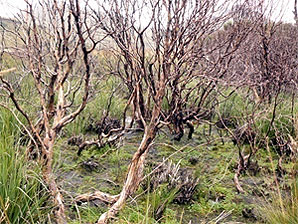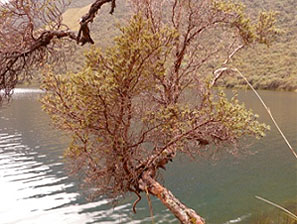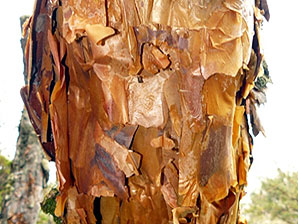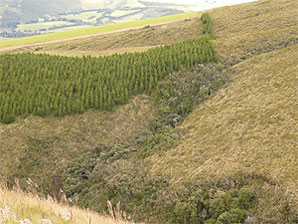
Photo by Galo Zapata-Rios
Far up in the Ecuadorian Andes, human encroachment is steadily overtaking Polylepis forests, a distinctive and ecologically important feature of the Andean highlands.
Commonly known as the paper tree (arbol de papel) due to its papery layers of bark, the genus grows in forests far beyond the elevation of other trees. These patches provide habitat on a harsh landscape, protect water supplies for human use and attract tourists. They are also shrinking rapidly.
Recent efforts by local and national agencies to reforest Polylepis habitat may at first glance look like a positive step, but widespread use of a non-native species has brought the potential for invasive hybrids that upset the balance of the very forests they are meant to protect. This non-native species, first introduced to Ecuador in 2000, threatens to bring a loss of biodiversity and species uniqueness as it out-competes indigenous species and hybridizes with them. Despite the potential consequences, little is known about the genetic relationships among the indigenous species or the extent to which hybridization with the non-native species is occurring.

Photo by Galo Zapata-Rios
Enter Claudia Segovia-Salcedo, a Ph.D. student at the Florida Museum of Natural History’s Molecular Systematics and Evolutionary Genetics Lab. From June to August 2008, Segovia-Salcedo traveled and hiked throughout the Ecuadorian Andes collecting samples from 29 populations of seven indigenous Polylepis species and P. racemosa, the species introduced from Peru.
In addition to collecting samples, Segovia-Salcedo also collected GPS data to find P. racemosa. “We know that we have that exotic species,” she said, “but we don’t know exact locations.”
Now she is designing molecular markers to analyze genetic diversity among the species and will use those markers to conduct a more in-depth genetic analysis in the field beginning this summer.
People are moving the introduced species to Ecuador without any technical assistance, she said. Segovia-Salcedo hopes to eventually work with local communities to improve the process of reforestation so that it doesn’t involve the introduced species. But to get there, she first must understand the genetic makeup of the different species and be able to recognize the extent to which hybridization has occurred.

Photo by Galo Zapata-Rios
High altitude forests
The Polylepis genus is part of the Rosaceae family, but its trees are a far cry from the rose bushes found in a summer garden. The name Polylepis means “many scales” in Latin and describes the papery, layered bark that characterizes the genus. The genus holds the world record for highest elevation for a tree. Its species grow at altitudes of 9,800 to 16,400 feet. Most Polylepis trees grow 33 to 49 feet tall, but can reach 148 feet at lower elevations. In places, trees that are permanently bent by the wind give the appearance of a magic forest, Segovia-Salcedo said.
Polylepis forests act as an important refuge for plant and animal species in the tundra-like environment of the Andes, providing food, shelter, moisture and warmth. The forests also serve as sponges that help protect and maintain the region’s water supply.

Photo by Galo Zapata-Rios
In Peru and Bolivia, forests of 5 to 12 acres are known to support as many as 40 bird species. Colombian researchers have found 41 bird species associated with Polylepis forests. Birds that live exclusively in these forests include the Giant Conebill (Polylepis), which is listed by the International Union for Conservation of Nature as “near threatened” due to habitat loss and fragmentation.
The full extent of species diversity supported by Polylepis forests in Ecuador is unknown, Segovia-Salcedo said. Researchers in Peru and Ecuador are researching the topic, and currently only unpublished species data is available.
Seven native species of Polylepis have been identified in Ecuador, two of them endemic. In 2000, government officials introduced the faster growing Peruvian species, P. racemosa, for reforestation.
The largest risk of hybridization appears to exist between the introduced P. racemosa and a sister species that is widely distributed in Ecuador, P. incana, Segovia-Salcedo said. But P. racemosa also has the potential to hybridize with the other species.
The push to reforest
Polylepis forests traditionally have been used for wood products such as charcoal. They are also cleared for agriculture. Combined with human population growth in major urban areas such as Quito, Ecuador’s capital, large tracts of forest have been lost or fragmented. The extent of Ecuador’s forest loss is unknown, but farther south in Bolivia, researchers found 87 percent of Polylepis forests surveyed in 1993 were gone by 2003.

Photo by Galo Zapata-Rios
Due to its faster growth and reproduction, the introduced species appeals to people who hope to attract tourists interested in experiencing a Polylepis forest, Segovia-Salcedo said. They also plant trees adjacent to national parks to expand their boundaries. Because park boundaries are not well defined, these plantings introduce P. racemosa to protected areas as well.
In some cases, the local government supplies the Peruvian species. In one case, Segovia-Salcedo said she hiked three hours to reach a forested tract of P. sericea, only to find P. racemosa planted beside it. The local government had given the introduced species to its citizens for expanding the forest and increasing its tourism value.
During her research, Segovia-Salcedo identified potential habitat for Polylepis forests based on an analysis of existing data. She found that most of the forests are found outside of national parks, so the park system is not working to protect indigenous species.
Some private landowners are ahead of the game and have found value in preserving the indigenous forests. One large private reserve about 45 minutes outside of Quito has 20 different species of hummingbirds, Segovia-Salcedo said. That forest contains only one indigenous species, P. sericea, and attracts plenty of tourists. Others, hoping to replicate that success, lack an understanding of the species needed to make the forest a valuable habitat, she said.
“We know now that racemosa is located on all of the Ecuadorian Andes except Loja, the southern province,” she said. “Right now we are trying to do some maps with all of the GPS data to know exactly where racemosa is because the people are not aware of the problem, and reforestation is sponsored by local government and the Ministry of Agriculture.”
Genetic dimensions of research
Much of Segovia-Salcedo’s research takes place in the genetics lab, far from the dramatic vistas of the Andes. She is currently designing molecular markers to help analyze the genetic diversity of the samples she collects.

Photo by Galo Zapata-Rios
Segovia-Salcedo is extracting DNA from one species to create a genomic library. Once extracted, the DNA is chopped into small fragments. Some of these fragments are selected to serve as microsatellites, short sequences of repetitive DNA that are used to detect genetic relationships. She then extracts DNA from her samples and compares microsatellites to find genetic differences among the species. This in turn will help her identify hybrid species.
Not all hybrids, however, are necessarily harmful. “Natural hybridization occurs among the (indigenous) species, and that is the reason it’s a complex group to work with,” she said. For example, two of the Ecuadorian species grow together, and hybrids between them are common. But the introduction of P. racemosa and the hybrids it produces will make the systematics more difficult to resolve.
Segovia-Salcedo hopes to begin working with local communities on reforestation efforts, but says it would probably equal another Ph.D.’s worth of work.
“It’s really nice that there’s nothing (else) done,” she said of her research, “but at the same time it involves a lot of field and lab work.”